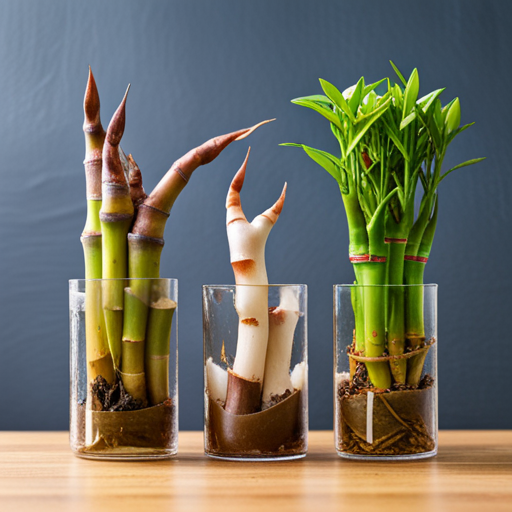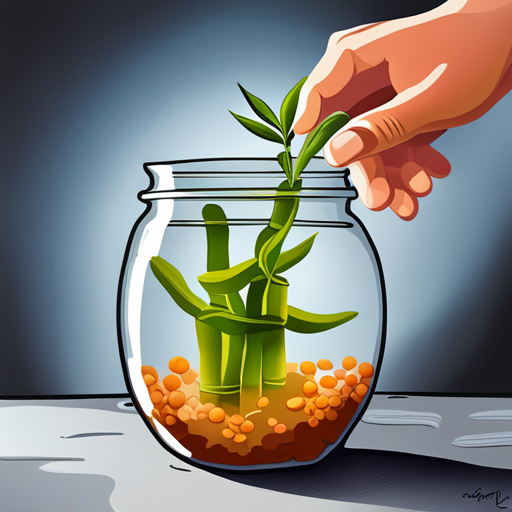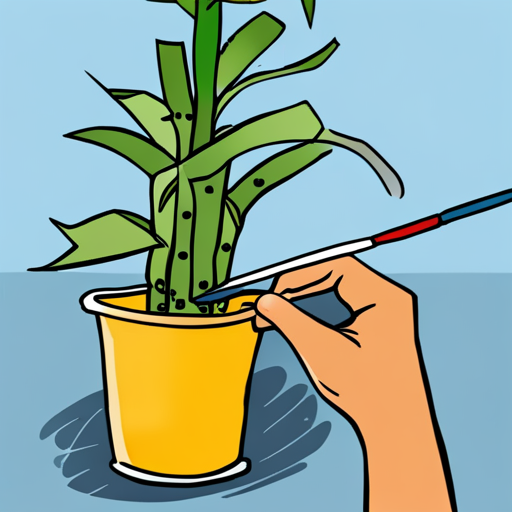When propagating lucky bamboo using the cutting method, it is important to select a healthy cutting of about four to six inches in length and remove the lower half’s bottom leaf buds, leaving only one set of leaves at the top. Applying rooting hormone can enhance the propagation process. The cutting should be planted in a shallow container with well-draining potting mix, ensuring that the cut end is buried about 2 inches into the soil.
Alternatively, lucky bamboo can be propagated in water by placing the cutting in a small glass filled with distilled water, with the remaining leaves above the water line to prevent rotting. Within approximately a month, roots should start forming, and the new plant can be potted in soil or a larger container of water and pebbles. Regular feedings are crucial to support its growth.
Contents
- 1 Our Highlighted Points
- 2 How to Plant Bamboo Shoots
- 3 Propagation in Water
- 4 Can I Propagate Lucky Bamboo in a Fish Tank?
- 5 Frequently Asked Questions
- 5.1 Can lucky bamboo be propagated from seeds?
- 5.2 How long does it take for lucky bamboo cuttings to root?
- 5.3 Can I propagate lucky bamboo from a leaf cutting?
- 5.4 Is it necessary to use rooting hormone when propagating lucky bamboo?
- 5.5 Can I propagate lucky bamboo in a vase of tap water instead of distilled water?
Our Highlighted Points
- Lucky bamboo can be propagated using two methods: planting bamboo shoots or cutting and planting sections of the bamboo stalk.
- When propagating lucky bamboo using the cutting method, a healthy cutting of about four to six inches in length should be selected.
- Rooting hormone can enhance the propagation process.
How to Plant Bamboo Shoots

One way to propagate lucky bamboo, as discussed previously, is by planting a bamboo shoot or by cutting a piece of bamboo into pieces and planting them in a pot.
When planting bamboo shoots, it is important to select a healthy cutting of about four to six inches in length from the parent stalk. The bottom leaf buds of the lower half of the cutting should be removed, leaving only one set of leaves at the top. Applying rooting hormone to the end of the cutting can enhance the propagation process.
The cut end of the lucky bamboo cutting should be inserted about 2 inches into well-draining potting mix to ensure stability and proper air circulation. Regular watering and placement in a bright, airy location are essential for the successful growth and care of the newly planted bamboo cuttings.
Propagation in Water

Propagation in water is a popular and effective method for expanding the growth of lucky bamboo plants.
This method offers several benefits. Firstly, it allows for easy monitoring of root growth, as the transparent container provides a clear view. Secondly, water propagation eliminates the need for soil, reducing the risk of overwatering or underwatering. Lastly, it is a visually appealing way to display the new plant as it forms roots and grows.
However, there are common mistakes to avoid when propagating lucky bamboo in water. One mistake is using tap water, which may contain chlorine that can harm the plant. It is crucial to use distilled or bottled water to ensure the health of the cutting. Another mistake is submerging the entire cutting in water, which can lead to rotting. Only the lower end of the cutting should be submerged, while the remaining leaves should be kept above the water line. Additionally, placing the vase in bright, indirect light is essential for successful propagation.
##

Water propagation is a visually appealing and effective method for expanding the growth of lucky bamboo plants. By placing a lucky bamboo cutting in a small glass filled with distilled water, roots will start forming within about a month. This method offers several propagation tips that can help ensure success. Firstly, it is important to use distilled or bottled water to avoid negative impacts from chlorine. Additionally, the cutting should be positioned in bright, indirect light to promote healthy growth. To prevent rotting, the remaining leaves should be kept above the water line. It is also crucial to regularly feed the new plant to support its growth. However, there are common mistakes to avoid, such as using tap water or placing the cutting in direct sunlight. Adhering to these propagation tips and avoiding common mistakes can greatly increase the chances of successful water propagation of lucky bamboo.
| Propagation Tips | Common Mistakes |
|---|---|
| Use distilled or bottled water | Using tap water |
| Position the cutting in bright, indirect light | Placing the cutting in direct sunlight |
| Regularly feed the new plant | Neglecting to feed the new plant |
Can I Propagate Lucky Bamboo in a Fish Tank?
Yes, you can propagate lucky bamboo in a fish tank. However, you should be mindful of the placement of lucky bamboo to ensure it does not interfere with the fish or their environment. It’s important to research and understand the specific needs of both the bamboo and the fish before attempting this.
Frequently Asked Questions
Can lucky bamboo be propagated from seeds?
Lucky bamboo cannot be propagated from seeds. Lucky bamboo propagation methods involve planting bamboo shoots or cutting pieces of bamboo and planting them. This method ensures the successful growth and development of new plants.
How long does it take for lucky bamboo cuttings to root?
The rooting time of lucky bamboo cuttings can vary, but under optimal conditions, roots should start forming within approximately one month. Factors such as using rooting hormone and providing a bright, airy environment can expedite the rooting process.
Can I propagate lucky bamboo from a leaf cutting?
Leaf propagation is not a recommended method for propagating lucky bamboo. Lucky bamboo is typically propagated by planting a bamboo shoot or by cutting a piece of bamboo into sections. These alternative methods have been found to be more effective.
Is it necessary to use rooting hormone when propagating lucky bamboo?
Using rooting hormone when propagating lucky bamboo can increase the efficiency of the process. However, alternative methods such as water propagation can also be effective. The benefits of rooting hormone include promoting faster root development and increasing the success rate of propagation.
Can I propagate lucky bamboo in a vase of tap water instead of distilled water?
Propagating lucky bamboo in different types of water is possible. While distilled water is recommended to avoid negative impacts from chlorine, tap water can also be used as an alternative method for propagating lucky bamboo.

